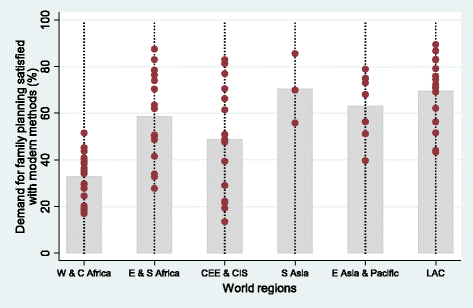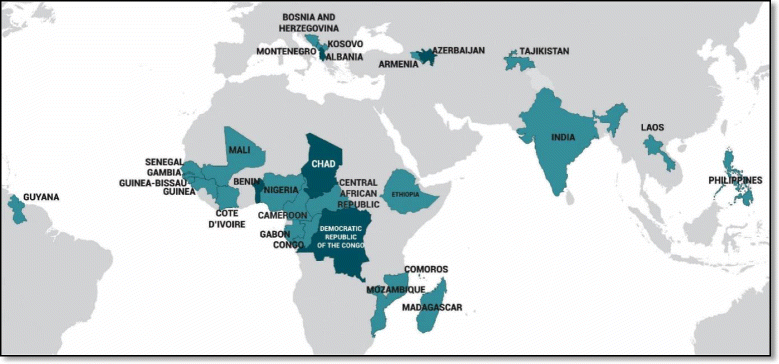Demand for family planning satisfied with modern methods among sexually active women in low- and middle-income countries: who is lagging behind?
- PMID: 29510682
- PMCID: PMC5840731
- DOI: 10.1186/s12978-018-0483-x
Demand for family planning satisfied with modern methods among sexually active women in low- and middle-income countries: who is lagging behind?
Abstract
Background: Family planning is key for reducing unintended pregnancies and their health consequences and is also associated with improvements in economic outcomes. Our objective was to identify groups of sexually active women with extremely low demand for family planning satisfied with modern methods (mDFPS) in low- and middle-income countries, at national and subnational levels to inform the improvement and expansion of programmatic efforts to narrow the gaps in mDFPS coverage.
Methods: Analyses were based on Demographic and Health Survey and Multiple Indicator Cluster Survey data. The most recent surveys carried out since 2000 in 77 countries were included in the analysis. We estimated mDFPS among women aged 15-49 years. Subgroups with low coverage (mDFPS below 20%) were identified according to marital status, wealth, age, education, literacy, area of residence (urban or rural), geographic region and religion.
Results: Overall, only 52.9% of the women with a demand for family planning were using a modern contraceptive method, but coverage varied greatly. West & Central Africa showed the lowest coverage (32.9% mean mDFPS), whereas South Asia and Latin America & the Caribbean had the highest coverage (approximately 70% mean mDFPS). Some countries showed high reliance on traditional contraceptive methods, markedly those from Central and Eastern Europe, and the Commonwealth of Independent States (CEE & CIS). Albania, Azerbaijan, Benin, Chad and Congo Democratic Republic presented low mDFPS coverage (< 20%). The other countries had mDFPS above 20% at country-level, yet in many of these countries mDFPS coverage was low among women in the poorest wealth quintiles, in the youngest age groups, with little education and living in rural areas. Coverage according to marital status varied greatly: in Asia & Pacific and Latin America & the Caribbean mDFPS was higher among married women; the opposite was found in West & Central Africa and CEE & CIS countries.
Conclusions: Almost half of the women in need were not using an effective family planning method. Subgroups requiring special attention include women who are poor, uneducated/illiterate, young, and living in rural areas. Efforts to increase mDFPS must address not only the supply side but also tackle the need to change social norms that might inhibit uptake of contraception.
Keywords: Contraception; Family planning; Health equity; Socioeconomic factors.
Conflict of interest statement
Ethics approval and consent to participate
This paper works with information from Multiple Indicator Cluster Surveys and Demographic and Health Surveys, both publicly available data sources. The ethical responsibility is entirely of the institutions that conducted the surveys in each country, eliminating the requirement of this study’s ethical approval.
Consent for publication
Not applicable.
Competing interests
The authors declare that they have no competing interests.
Publisher’s Note
Springer Nature remains neutral with regard to jurisdictional claims in published maps and institutional affiliations.
Figures


References
-
- Machiyama K, Casterline JB, Mumah JN, Huda FA, Obare F, Odwe G, Kabiru CW, Yeasmin S, Cleland J. Reasons for unmet need for family planning, with attention to the measurement of fertility preferences: protocol for a multi-site cohort study. Reprod Health. 2017;14:23. doi: 10.1186/s12978-016-0268-z. - DOI - PMC - PubMed
MeSH terms
Grants and funding
LinkOut - more resources
Full Text Sources
Other Literature Sources
Medical

